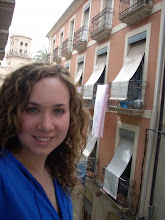How does the English-Spanish language barrier affect student-teacher relationships, particularly with Spanish-speaking students who do not speak English as their first language? What are the implications for classroom learning?
As I've surveyed the city and the high school, many findings of interest have come about. First off, West New York is a vibrant, urban environment with an unequivocal hispanic flare. That's no shock; its populat ion is about 80% hispanic. In walking just one block through the city, this fact becomes unmistakably apparent. Signs, restaurants and billboards all boast writing in Spanish (and sometimes leave out English altogether). I found it interesting that posted on one store window was a notice with versions in English and Spanish. The Spanish one was placed above the one written in English, signifying a greater need for customers to read the sign in Spanish. Examples of this were abundant throughout the city.
ion is about 80% hispanic. In walking just one block through the city, this fact becomes unmistakably apparent. Signs, restaurants and billboards all boast writing in Spanish (and sometimes leave out English altogether). I found it interesting that posted on one store window was a notice with versions in English and Spanish. The Spanish one was placed above the one written in English, signifying a greater need for customers to read the sign in Spanish. Examples of this were abundant throughout the city.
 ion is about 80% hispanic. In walking just one block through the city, this fact becomes unmistakably apparent. Signs, restaurants and billboards all boast writing in Spanish (and sometimes leave out English altogether). I found it interesting that posted on one store window was a notice with versions in English and Spanish. The Spanish one was placed above the one written in English, signifying a greater need for customers to read the sign in Spanish. Examples of this were abundant throughout the city.
ion is about 80% hispanic. In walking just one block through the city, this fact becomes unmistakably apparent. Signs, restaurants and billboards all boast writing in Spanish (and sometimes leave out English altogether). I found it interesting that posted on one store window was a notice with versions in English and Spanish. The Spanish one was placed above the one written in English, signifying a greater need for customers to read the sign in Spanish. Examples of this were abundant throughout the city.It's clear that Spanish is immensely important to the population of West New York. It's only natural that I found the school environment to be a reflection of the community. As I toured the building of Memorial High School, I heard just as much Spanish spoken as English. The students, the staff and the teachers all seemed to have at least a basic knowledge of Spanish, if they were not completely fluent.
While I interviewed Mariluz Garcia and Nila del Rio, both English as a Second Language (ESL) teachers, they effortlessly switched from speaking to me in English at one moment and speaking in Spanish to students and parents in another.
As both teachers came to the United States as immigrants from Cuba, they have an understanding of what some of the Memorial High students go through. Mariluz Garcia told me that many of her students come from poor Central American countries. Added to the fact that they have the pressures of school to think about, some have gone through hell to come to the U.S. Garcia told me that it's important to understand that many of her students have struggled through experiences many Americans couldn't even dream of. It's incredibly important to keep things like these in mind when teaching to these particular students.
So, what inherent qualities does a teacher need to possess in order to teach these types of students effectively? Kathy DeKranis, the English teacher I interviewed, said she doesn't know how to speak Spanish. But that doesn't stop her from trying her best when teaching her classes. While she sometimes has to threaten her students with extra work if they don't stop speaking in Spanish during class, she knows that these students can't help being who they are. Although DeKranis faces many difficulties with the language barrier in the classroom, she still loves her job and comes to accept the good with the bad.
In the case of urban communities similar to West New York, I'm learning that its a definite advantage if one knows how to speak Spanish. But this is not the end-all to becoming a successful teacher to students with limited English abilities. Above all, the ability to relate to your students is the most important factor.
Each teacher I spoke to knew where there students were coming from. The difficulties that stem from the language barrier - like poor standardized test scores and low school rankings - can definitely be discouraging to any teacher in this environment. However, my interviewees preached patience and, above all, a real understanding of one's students to facilitate classroom learning.

Its interesting to me that alot of the times english is the language that is left out. I could see an english speaking teacher struggling in this environment. I know that you speak spanish well which could make this culture fun for you but frustrating for others.
ReplyDelete